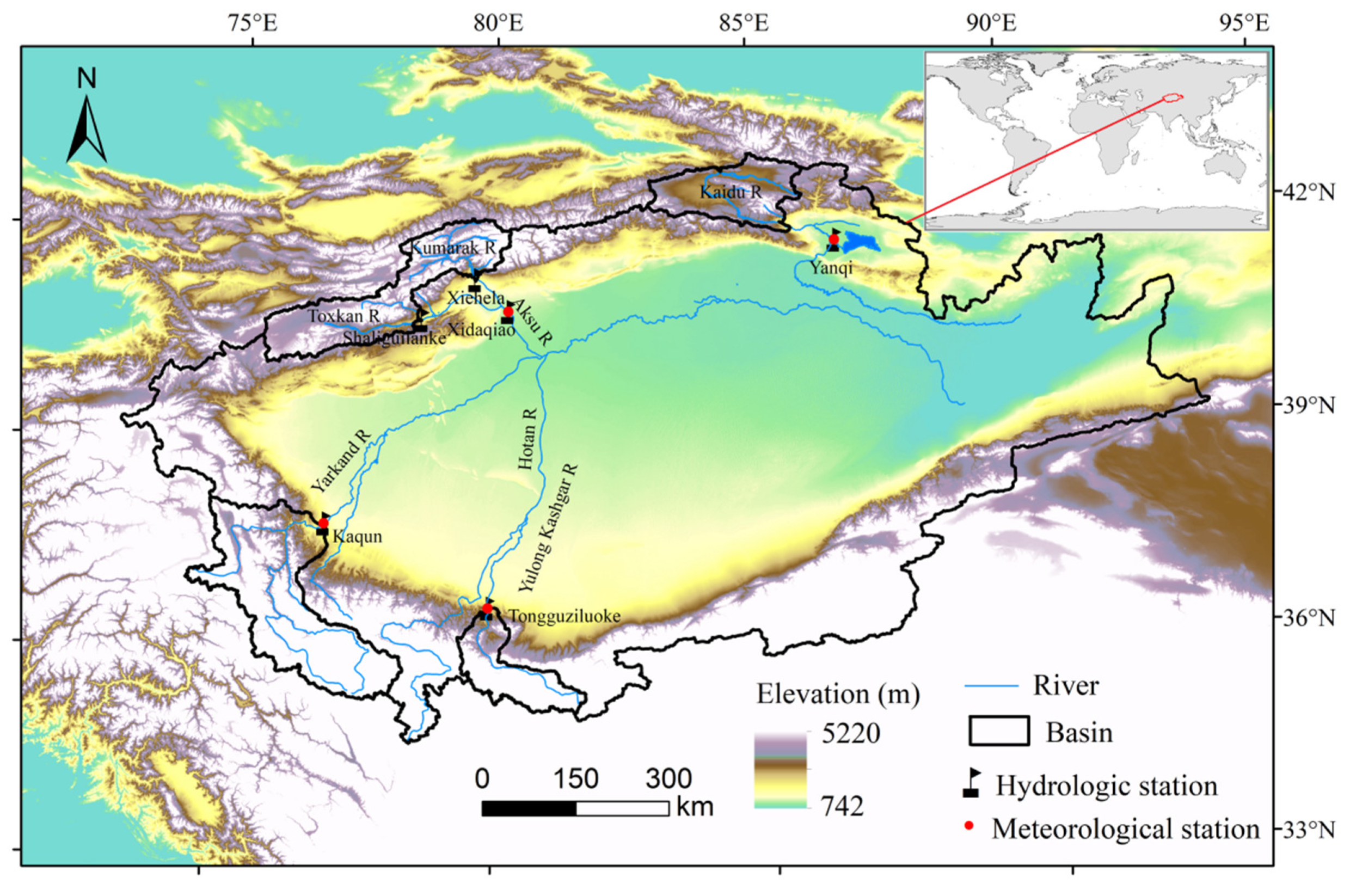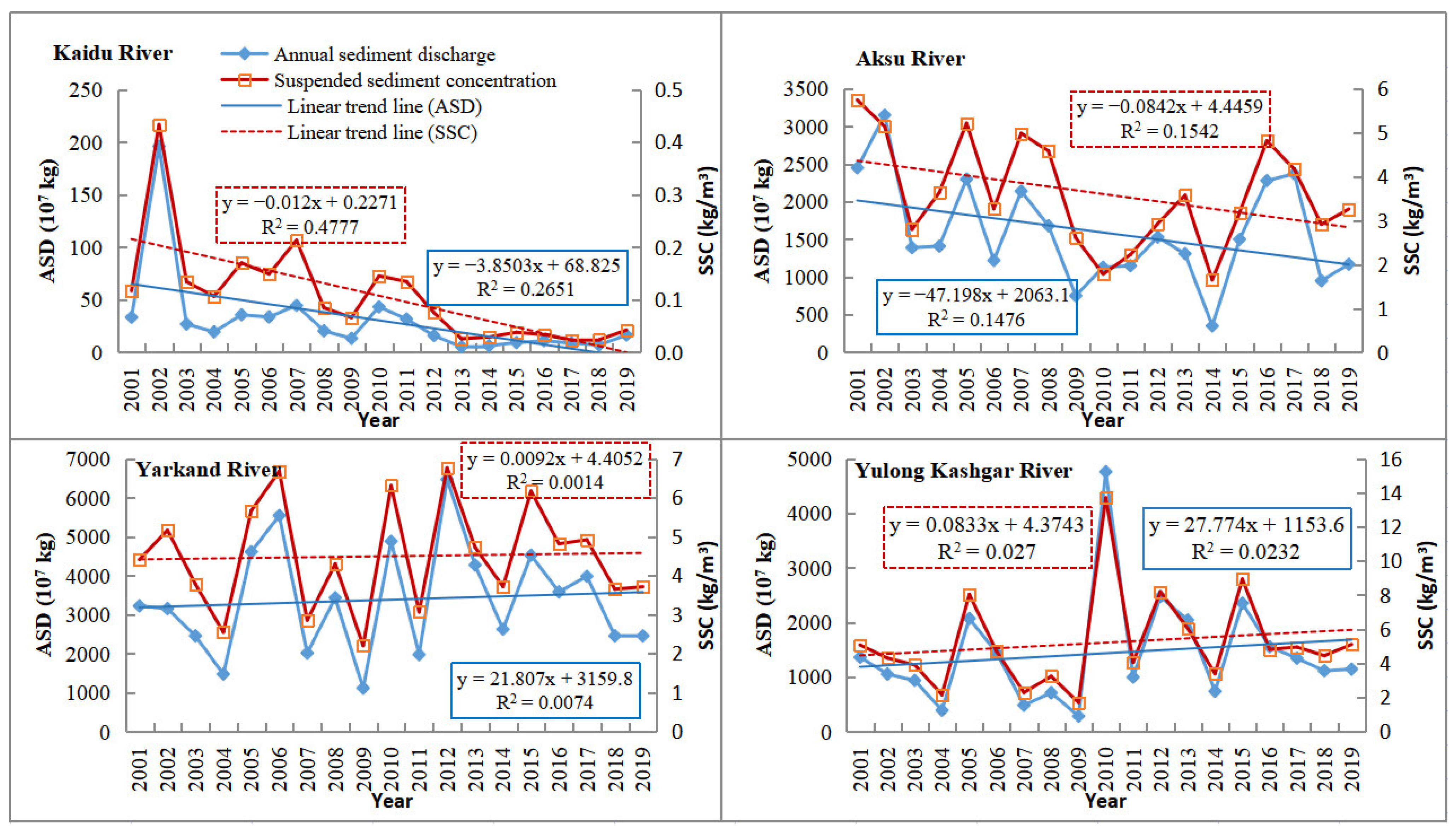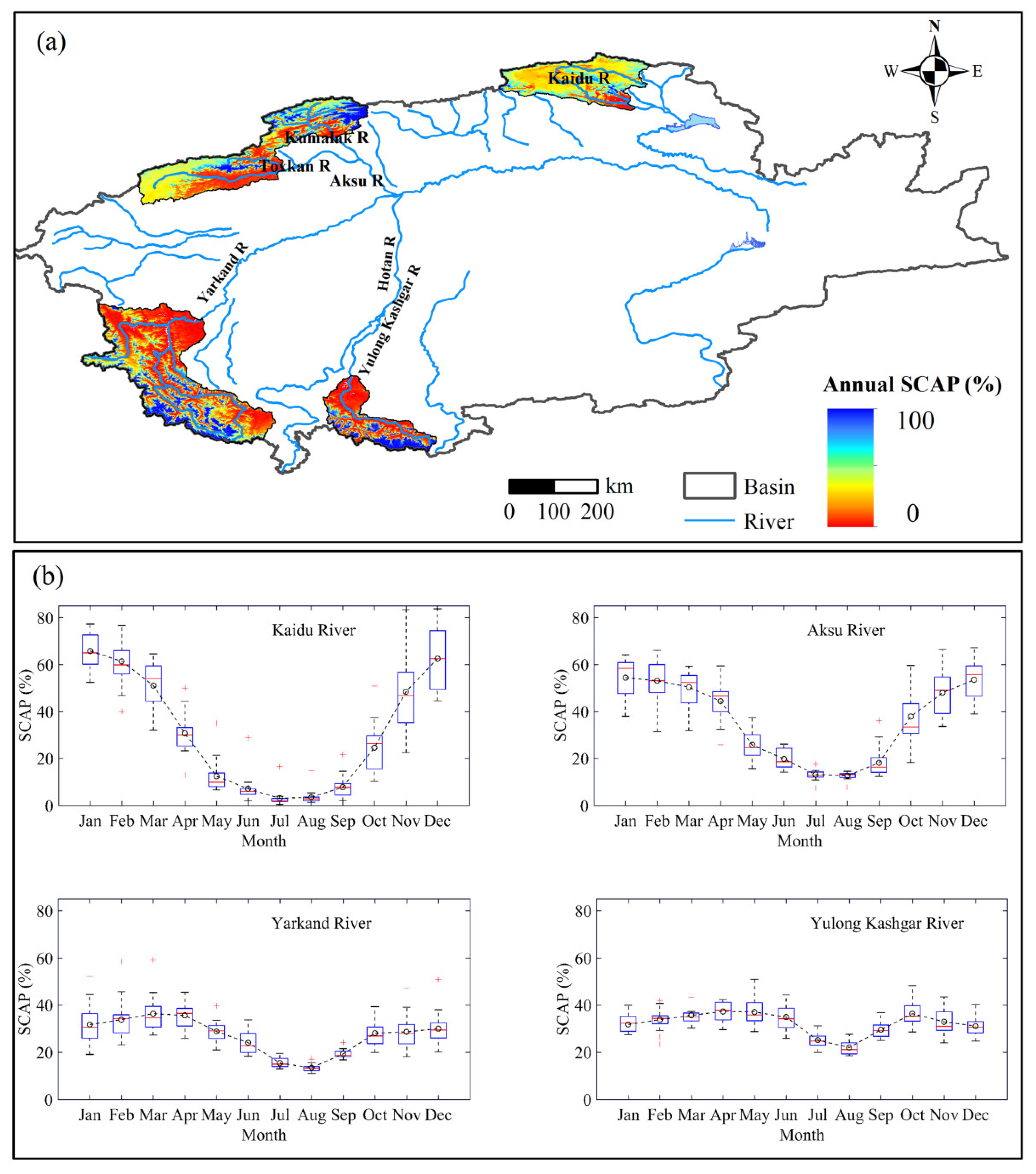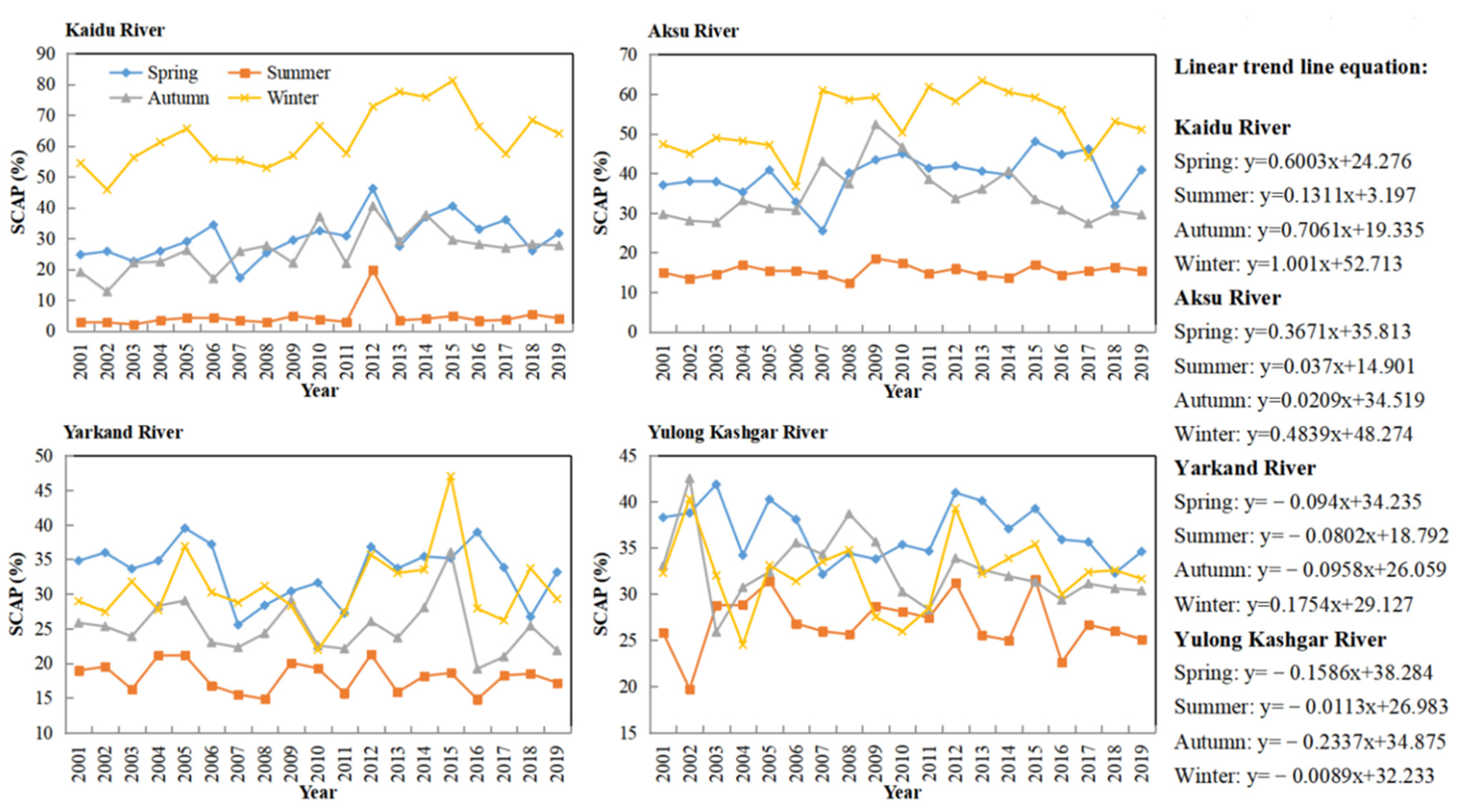Research on Sediment Discharge Variations and Driving Factors in the Tarim River Basin
Abstract
1. Introduction
2. Material and Methods
2.1. Study Area
2.2. Data
2.2.1. Meteorological and Hydrological Data
2.2.2. MODIS Snow Cover Product
2.3. Methods
2.3.1. Trend and Correlation Analysis
2.3.2. Sensitivity and Contribution Analysis
3. Results
3.1. Variations of Suspended Sediment
3.2. Change Rates of Precipitation, Temperature and Annual Runoff
3.3. The Spatial Distribution and Changes of SCAP in the TRB
3.4. Correlation, Sensitivity and Contribution Rate between Sediment Discharge and Driving Factors
4. Discussion
4.1. Effects of SCAP in Four Seasons and Other Factors on ASD
4.2. Other Possible Influencing Factors
4.3. The Significance of This Study
5. Conclusions
Author Contributions
Funding
Acknowledgments
Conflicts of Interest
References
- Wu, Y.P.; Chen, J. Modeling of soil erosion and sediment transport in the East River Basin in southern China. Sci. Total Environ. 2012, 441, 159–168. [Google Scholar] [CrossRef] [PubMed]
- Walling, D.E.; Fang, D. Recent trends in the suspended sediment loads of the world’s rivers. Glob. Planet. 2003, 39, 111–126. [Google Scholar] [CrossRef]
- Li, L.; Ni, J.R.; Chang, F.; Yue, Y.; Frolova, N.; Magrltsky, D.; Borthwick, A.G.L.; Ciais, P.; Wang, Y.C.; Zheng, C.M.; et al. Global trends in water and sediment fluxes of the world’s large rivers. Sci. Bull. 2020, 65, 62–69. [Google Scholar] [CrossRef]
- Yao, X.L.; Yu, J.S.; Jiang, H.; Sun, W.C.; Li, Z.J. Roles of soil erodibility, rainfall erosivity and land use in affecting soil erosion at the basin scale. Agric. Water Manag. 2016, 174, 82–92. [Google Scholar] [CrossRef]
- Zhang, K.L.; Cai, Y.M.; Liu, B.Y.; Jiang, Z.S. Evaluation of soil erodibility on the Loess Plateau. Acta Ecol. Sin. 2001, 21, 1687–1695. (In Chinese) [Google Scholar]
- Zhang, F.; Shi, X.; Zeng, C.; Wang, G.; Chen, Y.; Wang, L.; Zhang, H.; Yu, Z. Variation and influence of riverine sediment transport from Tibetan Plateau, China. Bull. Chin. Acad. Sci. 2019, 34, 1274–1284. (In Chinese) [Google Scholar]
- Zhao, Y.; Cao, W.H.; Hu, C.H.; Wang, Y.S.; Wang, Z.Y.; Zhang, X.M.; Zhu, B.S.; Cheng, C.; Yin, X.L.; Liu, B.; et al. Analysis of changes in characteristics of flood and sediment yield in typical basins of the Yellow River under extreme rainfall events. Catena 2019, 177, 31–40. [Google Scholar] [CrossRef]
- Syvitski, J.P.; Vörösmarty, C.J.; Kettner, A.J.; Green, P. Impact of humans on the flux of terrestrial sediment to the global coastal ocean. Science 2005, 308, 376–380. [Google Scholar] [CrossRef]
- Moragoda, N.; Cohen, S. Climate-induced trends in global riverine water discharge and suspended sediment dynamics in the 21st century. Glob. Planet. Chang. 2020, 191, 103199. [Google Scholar] [CrossRef]
- Chen, Y.N.; Li, Z.; Fang, G.H.; Deng, H.J. Impact of climate change on water resources in the Tianshan Mountians, Central Asia. Acta Geogr. Sin. 2017, 72, 18–26. (In Chinese) [Google Scholar] [CrossRef]
- Singh, P.; Singh, V.P. Snow and Glacier Hydrology; Kluwer Academic: Dordrecht, The Netherlands, 2001; pp. 309–414. [Google Scholar]
- Pomeroy, J.W.; Brun, E. Physical properties of snow. In Snow Ecology; Jones, H.G., Pomeroy, J.W., Walker, D.A., Hoham, R.W., Eds.; Cambridge University Press: Cambridge, UK, 2001; pp. 45–126. [Google Scholar]
- Bales, R.C.; Molotch, N.P.; Painter, T.H.; Dettinger, M.D.; Rice, R.; Dozier, J. Mountain hydrology of the western United States. Water Resour. Res. 2006, 42, W08432. [Google Scholar] [CrossRef]
- Whitaker, A.C.; Sugiyama, H.; Hayakawa, K. Effect of snow cover conditions on the hydrologic regim: Case study in a pluvial-nival watershed, Japan. J. Am. Water Resour. Assoc. 2008, 44, 814–828. [Google Scholar] [CrossRef]
- Iida, T.; Kajihara, A.; Okubo, H.; Okajima, K. Effect of seasonal snow cover on suspended sediment runoff in a mountainous catchment. J. Hydrol. 2012, 428–429, 116–128. [Google Scholar] [CrossRef]
- Duan, W.L.; He, B.; Takara, K.; Luo, P.P.; Nover, D.; Hu, M.C. Modeling suspended sediment sources and transport in the Ishikari River basin, Japan, using SPARROW. Hydrol. Earth Syst. Sci. 2015, 19, 1293–1306. [Google Scholar] [CrossRef]
- Duan, W.L.; Takara, K.; He, B.; Luo, P.P.; Nover, D.; Yamashiki, D. Spatial and temporal trends in estimates of nutrient and suspended sediment loads in the Ishikari River, Japan, 1985 to 2010. Sci. Total Environ. 2013, 461–462, 499–508. [Google Scholar] [CrossRef]
- Binh, D.V.; Kantoush, S.; Sumi, T. Changes to long-term discharge and sediment loads in the Vietnamese Mekong Delta caused by upstream dams. Geomorphology 2020, 353, 107011. [Google Scholar] [CrossRef]
- Fang, G.H.; Yang, J.; Chen, Y.N.; Li, Z.; Ji, H.P.; Maeyer, P.D. How hydrologic processes differ spatially in a Large Basin: Multi-site and multi-objective modeling in the Tarim River Basin. J. Geophys. Res. Atmos. 2018, 123, 7098–7113. [Google Scholar] [CrossRef]
- Delaney, I.; Adhikari, S. Increased subglacial sediment discharge in a warming climate: Consideration of ice dynamics, glacial erosion, and fluvial sediment transport. Geophys. Res. Lett. 2020, 47, e2019GL085672. [Google Scholar] [CrossRef]
- Chen, Y.N.; Li, W.H.; Xu, C.C.; Hao, X.M. Effects of climate change on water resources in Tarim River Basin, Northwest China. J. Environ. Sci. 2007, 19, 488–493. [Google Scholar] [CrossRef]
- Chen, Y.N.; Su, B.D.; Tao, H.; Zhao, C.Y.; Mao, W.Y. China Climate Change Impact Report: Tarim River Basin; China Meteorological Press: Beijing, China, 2014.
- Xu, C.C.; Chen, Y.N.; Hamid, Y.; Tashpolat, T.; Chen, Y.P.; Ge, H.T.; Li, W.H. Long-term change of seasonal snow cover and its effects on river runoff in the Tarim River basin, northwestern China. Hydrol. Processes 2009, 23, 2045–2055. [Google Scholar] [CrossRef]
- Mann, H.B. Nonparametric tests against trend. Econometrica 1945, 13, 245–259. [Google Scholar] [CrossRef]
- Kendall, M.G. Rank Correlation Methods; Springer: Bosten, MA, USA, 1975. [Google Scholar]
- Zhang, F.; Shi, X.N.; Zeng, C.; Wang, L.; Xiao, X.; Wang, G.X.; Chen, Y.; Zhang, H.B.; Lu, X.X.; Immerzeel, W. Recent stepwise sediment flux increase with climate change in the Tuotuo River in the central Tibetan Plateau. Sci. Bull. 2020, 65, 410–418. [Google Scholar] [CrossRef]
- Ke, C.Q.; Li, X.C.; Xie, H.J.; Liu, X.; Kou, C. Variability in snow cover phenology in China from 1952 to 2010. Hydrol. Earth Syst. Sci. 2016, 20, 755–770. [Google Scholar] [CrossRef]
- Kour, R.; Patel, N.; Krishna, A.P. Assessment of temporal dynamics of snow cover and its validation with hydro-meteorological data in parts of Chenab Basin, western Himalayas. Sci. China Earth Sci. 2016, 59, 1081–1094. [Google Scholar] [CrossRef]
- Huang, Y.Y. Study on the Relationship between the Changes of Snow Cover Area and Runoff in Upper Reaches of Yalong River; Lanzhou Jiaotong University: Lanzhou, China, 2016. (In Chinese) [Google Scholar]
- Zheng, H.G.; Zhang, L.; Zhu, R.R.; Liu, C.M.; Sato, Y.; Fukushima, Y. Responses of streamflow to climate and land surface change in the headwaters of the Yellow River Basin. Water Resour. Res. 2009, 45, W00A19. [Google Scholar] [CrossRef]
- Sanmiguel-Vallelado, A.; Camarero, J.J.; Morán-Tejeda, E.; Gazol, A.; Colangelo, M.; Alonso-González, E.; López-Moreno, J.I. Snow dynamics influence tree growth by controlling soil temperature in mountain pine forests. Agric. For. Meteorol. 2021, 296, 108205. [Google Scholar] [CrossRef]
- Hu, C.H.; Zhang, X.M.; Zhao, Y. Cause analysis of the centennial trend and recent fluctuation of the Yellow River sediment load. Adv. Water Sci. 2020, 31, 725–733. Available online: http://kns.cnki.net/kcms/detail/32.1309.P.20200611.1614.008.html (accessed on 2 October 2022). (In Chinese).
- Zhang, Q.F.; Chen, Y.N.; Li, Z.; Fang, G.H.; Xiang, Y.Y.; Li, Y.P.; Ji, H.P. Recent changes in water discharge in snow and glacier melt-dominated rivers in the Tianshan Mountains, Central Asia. Remote Sens. 2020, 12, 2704. [Google Scholar] [CrossRef]
- Wang, X.L.; Luo, Y.; Sun, L.; Shafeeque, M. Different climate factors contributing for runoff increases in the high glacierized tributaries of Tarim River Basin, China. J. Hydrol. Reg. Stud. 2021, 36, 100845. [Google Scholar] [CrossRef]
- Shao, Q.Q.; Xiao, T.; Liu, J.Y.; Qi, Y.Q. Soil erosion rates and characteristics of typical alpine meadow using 137Cs technique in Qinghai-Tibet Plateau. Chin. Sci. Bull. 2011, 56, 1708–1713. [Google Scholar] [CrossRef]
- An, S.S.; Darboux, F.; Cheng, M. Revegetation as an efficient means of increasing soil aggregate stability on the Loess Plateau (China). Geoderma 2013, 209–210, 75–85. [Google Scholar] [CrossRef]
- Qian, J.; Zhang, L.; Wang, W. Effects of vegetation cover and slope length on nitrogen and phosphorus loss from a sloping land under simulated rainfall. Environ. Stud. 2014, 23, 835–843. [Google Scholar]
- Li, J.Y.; Zhang, J. Natural controls of sediment yield in the major rivers in China. J. Ocean Univ. Qingda 2003, 33, 565–573. (In Chinese) [Google Scholar]
- Li, D.F.; Lu, X.X.; Yang, X.K.; Chen, L.; Lin, L. Sediment load responses to climate variation and cascade reservoirs in the Yangtze River: A case study of the Jinsha River. Geomorphology 2018, 322, 41–52. [Google Scholar] [CrossRef]






| River | Hydrologic Station | Longitude | Latitude | Altitude of Hydrologic Station (m) | Drainage Area (104 km2) | Slope of River (‰) | Average Runoff (2001–2019) (108 m3) |
|---|---|---|---|---|---|---|---|
| Kaidu River | Yanqi | 86°34′E | 42°02′N | 1058 | 2.25 | 4.45 | 26.19 |
| Aksu River | Xidaqiao | 80°15′E | 41°07′N | 1100 | 4.31 | 1.25 | 43.55 |
| Yarkand River | Kaqun | 76°54′E | 37°59′N | 1370 | 5.02 | 4.88 [6] | 72.20 |
| Yulong Kashgar River | Tongguziluoke | 79°55′E | 36°49′N | 1650 | 1.46 | 5.37 | 25.64 |
| River | ASD (2001–2019) (109 kg/year) | Runoff Depth (mm) | Sediment Modulus (t/km2) | Glacierization (%) | The Values of the Runoff Contribution | ||
| Kaidu River | 0.3 | 116.40 | 13.48 | 1.21 | Glacier-melt water: 14.1%; Precipitation and snow-melt water: 45.3%. | ||
| Aksu River | 15.91 | 101.04 | 369.18 | 9.46 | Glacier-melt water: 24.7–52.4%; Snow-melt water and precipitation: 30.4–45.1%. | ||
| Yarkand River | 33.78 | 144.82 | 672.89 | 1.45 | Glacier-melt water: 64%; Snow and precipitation: 13.4%. | ||
| Yulong Kashgar River | 14.31 | 175.60 | 980.39 | 0.30 | Glacier-melt water: 64.9%; Snow-melt water and precipitation: 17%. | ||
| River | Precipitation (mm/10a) | Temperature (°C/10a) | Annual Runoff (108m3/10a) |
|---|---|---|---|
| Kaidu River | 4.20 | 0.24 | 3.10 |
| Aksu River | 5.48 | 0.37 | −3.56 |
| Yarkand River | −3.83 | 0.42 * | 3.75 |
| Yulong Kashgar River | 4.63 | 0.28 | 0.18 |
| Basin | Annual Average SCAP (%) | CV Value | ||||
|---|---|---|---|---|---|---|
| Annual | Spring | Summer | Autumn | Winter | ||
| Kaidu River | 31.36 | 0.16 | 0.23 | 0.88 | 0.27 | 0.16 |
| Aksu River | 35.78 | 0.12 | 0.15 | 0.13 | 0.22 | 0.15 |
| Yarkand River | 27.05 | 0.11 | 0.14 | 0.14 | 0.16 | 0.18 |
| Yulong Kashgar River | 32.26 | 0.05 | 0.08 | 0.09 | 0.12 | 0.13 |
| River | Annual Runoff | Precipitation | Temperature | SCAP | ||||
|---|---|---|---|---|---|---|---|---|
| Spring | Summer | Autumn | Winter | |||||
| Kaidu River | Pearson correlation | 0.54 * | −0.05 | 0.10 | −0.38 | −0.16 | −0.54 * | −0.56 * |
| Sig. (two-tailed) | 0.02 | 0.85 | 0.70 | 0.15 | 0.54 | 0.03 | 0.02 | |
| Sensitivity coefficient | 2.60 | −0.14 | 2.27 | −0.72 | −0.28 | −2.94 | −5.33 | |
| Contribution rate | 62.3% | −8.0% | 13.4% | −17.7% | −17.3% | −87.2% | −59.8% | |
| Aksu River | Pearson correlation | 0.59 ** | −0.26 | 0.05 | 0.06 | −0.35 | −0.58 * | −0.37 |
| Sig. (two-tailed) | 0.01 | 0.28 | 0.46 | 0.82 | 0.17 | 0.02 | 0.16 | |
| Sensitivity coefficient | 1.02 | −0.27 | 0.48 | 0.15 | −1.46 | −1.26 | −1.09 | |
| Contribution rate | 27.8% | −11.9% | 2.2% | 1.9% | −17.8% | −19.0% | −12.5% | |
| Yarkand River | Pearson correlation | 0.88 ** | 0.17 | −0.32 | 0.55 * | 0.16 | −0.02 | 0.32 |
| Sig. (two-tailed) | 0.00 | 0.50 | 0.20 | 0.03 | 0.55 | 0.95 | 0.22 | |
| Sensitivity coefficient | 2.40 | 0.14 | −3.45 | 1.92 | 0.58 | −0.05 | 0.79 | |
| Contribution rate | 40.6% | 7.9% | −14.0% | 23.5% | 9.1% | −0.8% | 15.0% | |
| Yulong Kashgar River | Pearson correlation | 0.78 ** | 0.75 ** | −0.12 | 0.35 | 0.28 | −0.20 | −0.03 |
| Sig. (two-tailed) | 0.00 | 0.00 | 0.62 | 0.19 | 0.27 | 0.45 | 0.90 | |
| Sensitivity coefficient | 2.88 | 0.85 | −2.17 | 3.17 | 1.89 | −1.29 | −0.19 | |
| Contribution rate | 66.9% | 58.0% | −10.4% | 26.9% | 22.7% | −14.2% | −2.8% | |
| Kaidu River | SCAP | Yulong Kashgar River | Annual Runoff | |||
|---|---|---|---|---|---|---|
| Autumn | Winter | |||||
| Temperature in Autumn | Pearson correlation | −0.51 * | −0.51 * | Precipitation | Pearson correlation | 0.69 ** |
| Sig.(2-tailed) | 0.04 | 0.05 | Sig.(2-tailed) | 0.00 | ||
Publisher’s Note: MDPI stays neutral with regard to jurisdictional claims in published maps and institutional affiliations. |
© 2022 by the authors. Licensee MDPI, Basel, Switzerland. This article is an open access article distributed under the terms and conditions of the Creative Commons Attribution (CC BY) license (https://creativecommons.org/licenses/by/4.0/).
Share and Cite
Ye, Z.; Chen, Y.; Zhang, Q.; Liu, Y.; Zhang, X. Research on Sediment Discharge Variations and Driving Factors in the Tarim River Basin. Remote Sens. 2022, 14, 5848. https://doi.org/10.3390/rs14225848
Ye Z, Chen Y, Zhang Q, Liu Y, Zhang X. Research on Sediment Discharge Variations and Driving Factors in the Tarim River Basin. Remote Sensing. 2022; 14(22):5848. https://doi.org/10.3390/rs14225848
Chicago/Turabian StyleYe, Zhaoxia, Yaning Chen, Qifei Zhang, Yongchang Liu, and Xueqi Zhang. 2022. "Research on Sediment Discharge Variations and Driving Factors in the Tarim River Basin" Remote Sensing 14, no. 22: 5848. https://doi.org/10.3390/rs14225848
APA StyleYe, Z., Chen, Y., Zhang, Q., Liu, Y., & Zhang, X. (2022). Research on Sediment Discharge Variations and Driving Factors in the Tarim River Basin. Remote Sensing, 14(22), 5848. https://doi.org/10.3390/rs14225848










